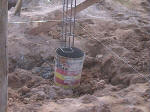 Right
after the pour of the base of a foundation post.
This shows a foundation post done much the same
way as a fence post, with a can filled with
concrete. This is an inadequate support
and can lead to problems with the most critical
part of the house and is not worth it to save a
few hundred Baht. (21-Apr-04) Right
after the pour of the base of a foundation post.
This shows a foundation post done much the same
way as a fence post, with a can filled with
concrete. This is an inadequate support
and can lead to problems with the most critical
part of the house and is not worth it to save a
few hundred Baht. (21-Apr-04) |
|
|
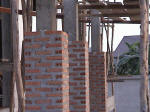 The
foundation columns should measure about 17
centimeters square. A common practice
nowadays is to use a real thin foundation post
with brick surrounding it. These are not
nearly as strong as the thicker all concrete
ones. (21-Apr-04) The
foundation columns should measure about 17
centimeters square. A common practice
nowadays is to use a real thin foundation post
with brick surrounding it. These are not
nearly as strong as the thicker all concrete
ones. (21-Apr-04) |
|
|
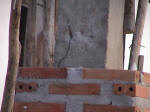 Here
is a close up showing a stress fracture on the
thin concrete foundation column. Here
is a close up showing a stress fracture on the
thin concrete foundation column. |
|
|
 The
thickness of the cement pours is sometimes
reduced in an effort to save money on the cost
of the cement. The normal thickness of a
floor is 10 centimeters (including tile).
This picture shows it being done correct.
(20-Apr-04) The
thickness of the cement pours is sometimes
reduced in an effort to save money on the cost
of the cement. The normal thickness of a
floor is 10 centimeters (including tile).
This picture shows it being done correct.
(20-Apr-04) |
|
|
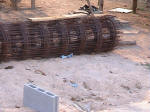 Prefabricated rolls of metal,
like the one shown here, are often used instead
of hand tied metal in laying a
floor. This leads to lower strength of the
floor. (21-Apr-04) Prefabricated rolls of metal,
like the one shown here, are often used instead
of hand tied metal in laying a
floor. This leads to lower strength of the
floor. (21-Apr-04) |
|
|
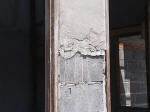 A
close-up of a wall section, between two windows,
where the stucco is in the process of being
applied. In this picture, the stucco is
being applied correctly to a thickness of about
one centimeter. Many builders will apply a paper thin layer of
stucco to save on cement costs.
The stucco is what gives the wall strength,
cutting here isn't worth it. (17-Apr-04) A
close-up of a wall section, between two windows,
where the stucco is in the process of being
applied. In this picture, the stucco is
being applied correctly to a thickness of about
one centimeter. Many builders will apply a paper thin layer of
stucco to save on cement costs.
The stucco is what gives the wall strength,
cutting here isn't worth it. (17-Apr-04) |
|
|
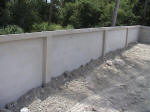 A
wall with thin stucco and posts done 3.5 meters
apart instead of 2.5 meters. The wall
isn't going to fall over, but 2.5 meters between
posts is the standard, and greater than this
does make the wall weaker. (06-Jul-04) A
wall with thin stucco and posts done 3.5 meters
apart instead of 2.5 meters. The wall
isn't going to fall over, but 2.5 meters between
posts is the standard, and greater than this
does make the wall weaker. (06-Jul-04) |
|
|
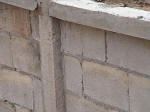 Here
is a wall section in which the support post was
poured before the blocks were laid. You
can tell by looking at the seam between the post
and the adjoining cement blocks. This
leads to a wall of less strength. Another
thing which occurs frequently is that metal cross supports are not used to
attach the post to the adjacent blocks.
(14-Jul-04) Here
is a wall section in which the support post was
poured before the blocks were laid. You
can tell by looking at the seam between the post
and the adjoining cement blocks. This
leads to a wall of less strength. Another
thing which occurs frequently is that metal cross supports are not used to
attach the post to the adjacent blocks.
(14-Jul-04) |
|
|
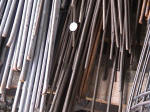 Metals
are expensive, this is an area which is squeezed
constantly. Develop a list before doing
your house specifying the full list of metals to
be used. Although rebar stands are shown
here, this also includes roof metal uses much
metal. (03-May-04) Metals
are expensive, this is an area which is squeezed
constantly. Develop a list before doing
your house specifying the full list of metals to
be used. Although rebar stands are shown
here, this also includes roof metal uses much
metal. (03-May-04) |
|
|
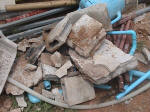 These
chunks of blocks were pulled from the outside of
a well and were used more to save time than
money. The outside of a well should be
seasoned with small stones which will prevent
air pockets from forming on the outside of the
cement rings. (12-Jul-04) These
chunks of blocks were pulled from the outside of
a well and were used more to save time than
money. The outside of a well should be
seasoned with small stones which will prevent
air pockets from forming on the outside of the
cement rings. (12-Jul-04) |
|
|
 While
this septic has adequate rings, this is one area
you wouldn't want to skimp on. (22-Apr-04) While
this septic has adequate rings, this is one area
you wouldn't want to skimp on. (22-Apr-04) |
|
|
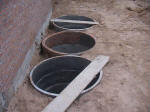 Septics
done like this will save a little digging, but
water will seep between septics and the dirt
surrounding each septic would not be as firm as
if each were dug independently.
(02-Jul-04) Septics
done like this will save a little digging, but
water will seep between septics and the dirt
surrounding each septic would not be as firm as
if each were dug independently.
(02-Jul-04) |
|
|
 Ceiling
supports, here done properly. Corner
cutters will use a minimum of supporting metal,
which will cause the roof to sag over time.
(07-May-04) Ceiling
supports, here done properly. Corner
cutters will use a minimum of supporting metal,
which will cause the roof to sag over time.
(07-May-04) |
|
|
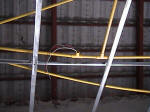 Proper
electric conduit, corner cutters will have raw
wire run above the ceiling. This is one
thing which
can be checked as a part of a home inspection.
(18-May-04) Proper
electric conduit, corner cutters will have raw
wire run above the ceiling. This is one
thing which
can be checked as a part of a home inspection.
(18-May-04) |
|
|
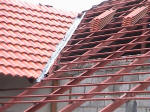 An
example of inadequate roof flashing material of
inadequate width being installed in the roof
valley. The roof flashing installed in the
valley should have a width of almost a meter. (21-May-04) An
example of inadequate roof flashing material of
inadequate width being installed in the roof
valley. The roof flashing installed in the
valley should have a width of almost a meter. (21-May-04) |
|
|
 A
circuit breaker. Corner cutter tricks are
running all the wires into one station and not
have a ground wire run to earth.
(19-Jun-04) A
circuit breaker. Corner cutter tricks are
running all the wires into one station and not
have a ground wire run to earth.
(19-Jun-04) |
|
|
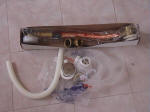 As
far as bathtub plumbing it is imperative to end
up with the proper gear. This example
shows a good quality heavy copper drain setup above, and a
typical plastic corner cutter layout below.
Repairs after the tub is plumbed in are
difficult, costly and time consuming.
(23-Jun-04) As
far as bathtub plumbing it is imperative to end
up with the proper gear. This example
shows a good quality heavy copper drain setup above, and a
typical plastic corner cutter layout below.
Repairs after the tub is plumbed in are
difficult, costly and time consuming.
(23-Jun-04) |
|
|
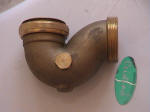 Again,
the bathtub. A 'p-trap' should be
installed below the tub. This is hard to
fix after the tub is fully plumbed in.
(24-Jun-04) Again,
the bathtub. A 'p-trap' should be
installed below the tub. This is hard to
fix after the tub is fully plumbed in.
(24-Jun-04) |
|
|
|
Finally the bathtub
proper. Plumbing in a bathtub is time and
material intensive. After a bathtub is
plumbed in, repairs would require extensive
rework. It just isn't worth it to put in a
cheap plastic bathtub, better to have no bathtub
at all. The cheapest plastic bathtubs cost
around 2000 Baht, good quality acrylic ones
start at about 5000 Baht. |
|
|
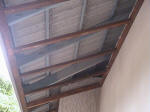 An
example of a house using coconut wood as support
for outside grc sheeting. This wood
degrades quickly and will lead to problems in a
few years time. (25-Jul-04) An
example of a house using coconut wood as support
for outside grc sheeting. This wood
degrades quickly and will lead to problems in a
few years time. (25-Jul-04) |
|
|
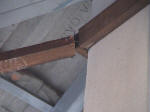 Close-up
of inadequate coconut wood used to support
grc sheeting. (25-Jul-04) Close-up
of inadequate coconut wood used to support
grc sheeting. (25-Jul-04) |
|
|
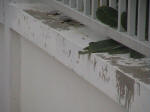 This
was just painted. No paint at all is
better than low quality paint that comes off
when put in contact with water.
(25-Jul-04) This
was just painted. No paint at all is
better than low quality paint that comes off
when put in contact with water.
(25-Jul-04) |
|
|
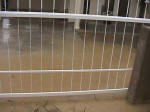 This
shows the worst offense: inadequate fill dirt at
the start of construction means the house will
flood later. It is a problem which is very
difficult to correct. (18-Jun-04) This
shows the worst offense: inadequate fill dirt at
the start of construction means the house will
flood later. It is a problem which is very
difficult to correct. (18-Jun-04) |
|
|
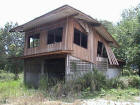 What
happens if you cut one too many corners!
(09-Apr-04) What
happens if you cut one too many corners!
(09-Apr-04) |
|
|
|
|

